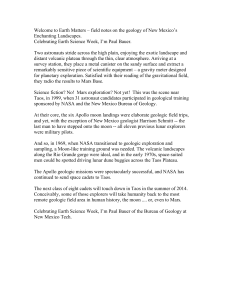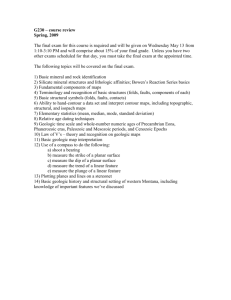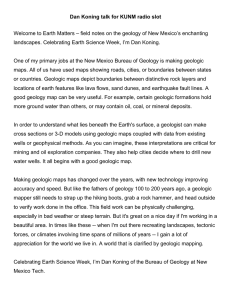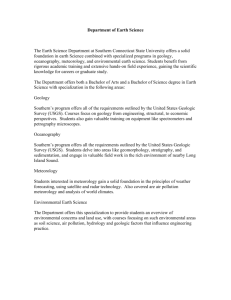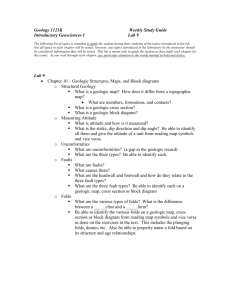Geologic Cross Sections and Preliminary Geologic Map by
advertisement
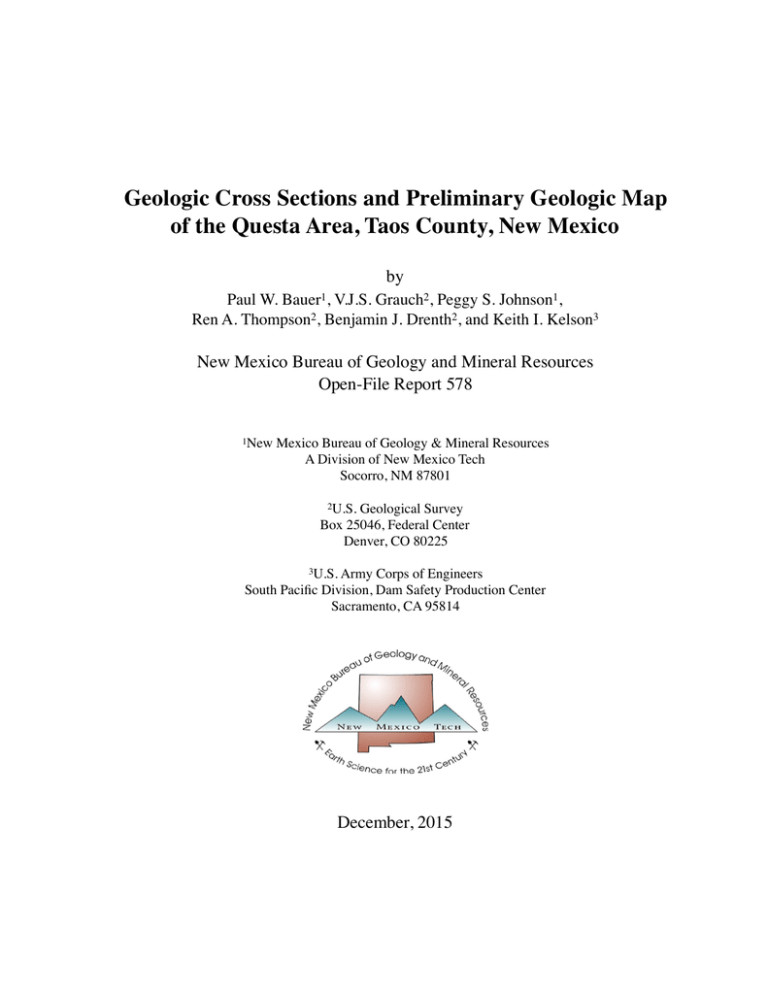
Geologic Cross Sections and Preliminary Geologic Map of the Questa Area, Taos County, New Mexico by Bauer1, Paul W. V.J.S. Grauch2, Peggy S. Johnson1, Ren A. Thompson2, Benjamin J. Drenth2, and Keith I. Kelson3 New Mexico Bureau of Geology and Mineral Resources Open-File Report 578 1New Mexico Bureau of Geology & Mineral Resources A Division of New Mexico Tech Socorro, NM 87801 2U.S. Geological Survey Box 25046, Federal Center Denver, CO 80225 3U.S. Army Corps of Engineers South Pacific Division, Dam Safety Production Center Sacramento, CA 95814 December, 2015 PURPOSE AND SCOPE OF THE STUDY In 2011, the senior authors were contacted by Ron Gardiner of Questa, and Village of Questa Mayor Esther Garcia, to discuss the existing and future groundwater supply for the Village of Questa. This meeting led to the development of a plan in 2013 to perform an integrated geologic, geophysical, and hydrogeologic investigation of the Questa area by the New Mexico Bureau of Geology & Mineral Resources (NMBG), the U.S. Geological Survey (USGS), and New Mexico Tech (NMT). The NMBG was responsible for the geologic map and geologic cross sections. The USGS was responsible for a detailed geophysical model to be incorporated into the NMBG products. NMT was responsible for providing a graduate student to develop a geochemical and groundwater flow model. This report represents the final products of the geologic and geophysical investigations conducted by the NMBG and USGS. The USGS final products have been incorporated directly into the geologic cross sections. The objective of the study was to characterize and interpret the shallow (to a depth of approximately 5,000 ft) three-dimensional geology and preliminary hydrogeology of the Questa area. The focus of this report is to compile existing geologic and geophysical data, integrate new geophysical data, and interpret these data to construct three, detailed geologic cross sections across the Questa area. These cross sections can be used by the Village of Questa to make decisions about municipal water-well development, and can be used in the future to help in the development of a conceptual model of groundwater flow for the Questa area. Attached to this report are a location map, a preliminary geologic map and unit descriptions, tables of water wells and springs used in the study, and three detailed hydrogeologic cross sections shown at two different vertical scales. The locations of the cross sections are shown on the index map of the cross section sheet. FUNDING Funding for the NMBG study was provided by the Healy Foundation and the New Mexico Bureau of Geology & Mineral Resources. Funding for USGS geophysical modeling was procured by Mayor Ester Garcia (total of $24,000; $12,000 from the Village of Questa and $12,000 from Chevron) and 2 of 16 by Peggy Johnson via the Healy Foundation project funds ($2000). Funding for NMT graduate student, Kylian Robinson, is being provided by the Aquifer Mapping Program at the NMBG. DISCLAIMER Any use of trade, product, or firm names is for descriptive purposes only and does not imply endorsement by the U.S. Government or the State of New Mexico. GEOLOGIC SETTING The Village of Questa is located in the San Luis Basin of the Rio Grande rift, along the eastern edge of the Taos Plateau volcanic field. The village lies between the crystalline rocks of the Sangre de Cristo Mountains to the east, and the volcanic edifice of Guadalupe Mountain to the west. The rocks exposed in the mountains are a complex mixture of Paleoproterozoic metamorphic rocks and Tertiary igneous rocks of the Questa caldera and Latir volcanic field. Along the eastern edge of the village, the large-displacement normal faults of the Sangre de Cristo fault system mark the transition from the down-dropped rift basin to the uplifted mountains. The village is built on Tertiary and Quaternary basin-fill sediments that have been shed off of the Sangre de Cristo Mountains. The Red River, which flows westerly through the village, has locally cut deep canyons into the Sangre de Cristo Mountains and the Taos Plateau volcanic field. Cabresto Creek is the principal Red River tributary in the village area. D ATA U S E D Project work began with the development of the following two datasets, which are included as tables in this report. 1. A database of select water wells in the Questa area (Table 1), including wells owned by Chevron, Inc. Most of these data were compiled by Kylian Robinson and Kitty Pokorny (NMBG). The database was developed from a variety of sources, including: New Mexico Office of the State Engineer well records, consultant reports, Chevron reports, New Mexico Environment Department (NMED) data, and NMBG data. Although most of the wells have some useful records (such as drillers logs, geologists logs, geophysical logs, pump tests, water 3 of 16 quality analyses), no records (or incomplete records) exist for a number of the wells. It is possible that these records are preserved elsewhere, but could not be located during this study. 2. An inventory and map of springs in the Questa area (Table 2). The springs inventory was developed during multiple field visits over several years by NMBG and NMED staff and field assistants. Springs were visited during field surveys along the Red River. Their locations were determined using a handheld GPS. Water-quality field parameters and samples were taken on select springs, and discharges were estimated where possible. These data - along with existing spring data from the Rio Grande gorge (Bauer et al., 2007) - were entered into a database, and a digital map of the field stations was created. The data sets used in this investigation include: 1. Preliminary geologic map of the Guadalupe Mountain and Questa quadrangles (Plate 1) developed by the NMBG STATEMAP program in partnership with Ren Thompson (USGS). The map shows the locations of the three cross sections, the surface distribution of geologic units, and short descriptions of the geologic units shown on the map and on the cross sections. For the purposes of this report, the bedrock units in the Sangre de Cristo Mountains have been combined into a single unit (Tu & XYu); 2. Existing subsurface geologic and geophysical data from water-well records, lithologic logs, and borehole geophysics; 3. New and existing geophysical data and interpretations by the USGS (Grauch et al., 2015); 4. Depth-to-water measurements and spring locations collected by the NMBG in 2013 and 2014 (Tables 1 and 2); 5. Historic depth-to-water data from a variety of published and unpublished sources (Table 1). GEOLOGIC CROSS SECTIONS We developed three, new geologic cross sections for this study (Plate 2). The locations of sections were chosen to optimize hydrogeologic understanding, maximize the number of useful wells that could be incorporated into the section lines, and utilize the geophysical interpretations provided by Tien Grauch and Ben Drenth (USGS). The topographic profiles were generated by ArcGIS software. Cross sections were drawn as vertically exaggerated by a factor of five to better 4 of 16 illustrate the shallow hydrologic and geologic details. On the cross-section sheet, all three of the sections are also shown with no vertical exaggeration. Data Sources The geologic units shown in the cross sections were established from three principal data sources: 1) Local and regional geologic maps; 2) Interpretations from borehole geology and borehole geophysics; and 3) Interpretations from three geophysical data sets (high-resolution aeromagnetic survey, ground-magnetic surveys, and gravity modeling). Each of these three data sets is briefly summarized below. 1. Geologic map. The principal geologic map used in this study is a preliminary digital version of the Questa and Guadalupe Mountain 7.5-minute quadrangles (Kelson et al., 2008; Kelson et al., 2013) produced by the NMBG STATEMAP program. This 1:24,000 scale map shows the distribution of rock units and unconsolidated, surficial, sand and gravel deposits, as well as the locations of known faults. See Appendix 1 for descriptions of the geologic units. Some of the geologic units shown in the cross sections are not exposed at the surface in the study area. However, these units are exposed in the nearby areas where they have been mapped and analyzed. In the three Questa cross sections, the physical characteristics of some of these units (such as composition, thickness, texture, and lateral extent) are based on work in nearby areas by the authors. 2. Boreholes. The geologic and geophysical data attached to the drill holes in the study area ranged from wells with no data attached, to wells with extensive sets of detailed lithologic cutting analyses, different types of borehole geophysics, and a variety of aquifer and waterquality tests. Domestic well records in the study area are only marginally useful for defining the subsurface stratigraphy, as most well drillers do not record the detailed characteristics of well cuttings. In contrast, geologic logs developed by geologists who examined well cuttings (such as those logged by Chevron and associated geotechnical consultants) are generally very helpful for defining the subsurface stratigraphy. 5 of 16 3. Geophysics. A combination of existing and new geophysical studies in the Questa area were incorporated into this investigation (Grauch et al., 2015). Each of the geophysical techniques can be used alone to provide useful constraints on the subsurface geology, but the real value of these data sets is that when they are interpreted collectively by a geophysicist, they can provide immensely valuable, detailed information on the subsurface geology. Each of the geophysical studies used in the current study are summarized below. a) Existing high-resolution aeromagnetic survey (Tien Grauch, USGS). In 2003, the USGS began to acquire high-resolution aeromagnetic surveys for the San Luis Basin (Bankey et al., 2005, 2006). For the current study, parts of the existing data set were reexamined in order to develop an aeromagnetic anomaly map of the Questa study area that shows buried faults and buried volcanic rocks. This method can be extremely effective at delineating large-scale, horizontal and vertical variations of rock types in the subsurface. b) New ground-magnetic surveys (Tien Grauch, USGS). In April 2014, Tien Grauch performed select ground-based magnetic traverses across the Questa area (Grauch et al., 2015). This method can precisely locate buried faults and other features that juxtapose materials with different magnetic properties. c) Gravity surveys and regional gravity model (Ben Drenth, USGS). In April 2014, Ben Drenth collected new gravity data to fill holes in data coverage in the existing regional data base for the San Luis Basin. He then developed a regional model of the data for the basin, following methods discussed in Drenth et al. (2013). His main goal for the Questa area was to improve understanding of the thickness of the basin-fill materials. This method is especially useful for estimating the general depth to basement rocks and for locating large-offset basement faults. The fault structures depicted in the cross sections were established from three data sources: 1) mapped faults from the geologic map; 2) inferred faults from the magnetic and gravity surveys; and 3) a conceptual model of the geometry and kinematics of the northern Rio Grande rift. Each of these three data sets is summarized below. Readers should note that imposing a vertical exaggeration of five on cross sections results in the apparent steepening of faults. Based on measurements of faults 6 of 16 exposed in the Sangre de Cristo Mountains, the average dip of faults in this area is approximately 60 to 70 degrees. On the exaggerated cross sections, these dips appear much steeper. 1. The geologic maps (Kelson et al., 2008, 2013) show a large number of segmented normal fault splays along the Sangre de Cristo fault zone east of Questa, and other zones of faults within the rift basin. On the cross sections, such faults are labeled “mapped fault.” 2. Modern geophysical techniques using high-resolution magnetic and gravity data (Grauch et al., 2015) are capable of defining buried faults in Rio Grande rift basins, such as in the Questa area. Tien Grauch and Ben Drenth have refined these techniques in the Rio Grande rift. They are currently capable of processing these data in ways that allow them to draw the locations of faults that generate geophysical anomalies. On the cross sections, such faults are labeled “geophysical fault.” It is worth noting that there is good correlation between the mapped faults and the geophysically defined faults. Such correspondence elevates our confidence in the delineation of buried faults by such geophysical techniques. Recent gravity modeling by Ben Drenth provides an extremely useful tool for estimating the thickness of basin-fill deposits in the rift basin. This technique yields a depth-to-basement curve for the cross sections. As the basement deepens away from the edge of the rift, numerous buried faults must exist in order to deepen the basement. On the cross sections, such faults are labeled “inferred fault.” 3. The conceptual geologic model for the development of this part of the southern San Luis basin of the Rio Grande rift (Kelson et al., 2008, 2013), provides a framework for presenting the geometry and kinematics of the local rift structures. In the Questa area, the west-down normal faults of the Sangre de Cristo fault system are expected to be the dominant buried features. The Red River fault is an east-down, normal fault zone. Development of the Cross Sections The following list describes the general steps that were taken to create each of the geologic cross sections developed for this study: 1. Geologic contacts are derived from the geologic map. The surface geology is taken from the geologic map and placed on the topographic profile of the cross sections. Geologic 7 of 16 contacts that are buried by thin surficial deposits were estimated. Some of the thinnest (generally less than several meters) Quaternary surficial deposits are not shown on the cross sections. 2. The gravity model is used to define the depth to basement rocks in the cross sections. The base of the cross sections are constrained by the depth-to-basement curve derived from the USGS gravity model, described above. The depth-to-basement curve depicts a highly smoothed contact between basin-fill sediments and bedrock. In the model, Tertiary igneous rocks of the Questa caldera/Latir volcanic field and Proterozoic crystalline rocks are considered to be bedrock. 3. Geologic information derived from the wells is added to the cross sections. Poorly studied wells have limited value for developing cross-section stratigraphy, especially for the basin-fill sediments. However, expertly studied wells can help define the regional thicknesses and depths of key stratigraphic formations, including some of the basin-fill units such as the Lama Formation and thick clay horizons. Most of the basin-fill stratigraphy (Santa Fe Group (Tsf), Chamita Formation (Tc), and Lama Formation (QTL)) consists of poorly sorted, clay-toboulder sized, alluvial material that was eroded from the nearby mountains. Unless the compositions and proportions of rock clasts and the color of the sediment is well described, it is not possible to tell them apart in drill holes. Although the depictions of these two units on the cross sections are based principally on borehole data, local stratigraphic relationships, and an understanding of the sedimentary systems and geologic processes of the area, it is possible that the thicknesses of the various basin-fill units are not accurately represented. For example, it is generally not possible to confidently place the contact between the Chamita Formation (Tc) and the Lama Formation (QTL) where the Servilleta Formation is absent. 4. Mapped and inferred faults are drawn onto the cross sections. For the purposes of this study, the dips of the inferred faults were estimated to be between 60 and 70 degrees westward, unless evidence existed for some other orientation. In all cases, the geometries of the normal faults drawn in the cross sections are intentionally simplified as single inclined planes, when in fact all of the mapped normal faults in this area have much more complex geometries. They are typically curved, segmented, branched, and composed of multiple 8 of 16 overlapping fault planes. Where exposed, faults in bedrock typically display wide fracture zones with high permeabilities, whereas faults in basin-fill sediments commonly display narrow, clay-rich cores with lower permeabilities. 5. Interpretations from geophysics are added to cross sections. Additional information gleaned from the geophysical work is added to the cross sections. For example, this includes evidence for buried volcanic rocks or for differentiating buried volcanic rocks into separate volcanic units (Grauch et al., 2015). 6. Conceptual models of volcanic and sedimentary processes are incorporated into cross sections. This phase of work was principally done by Ren Thompson, who used his extensive knowledge of the Taos Plateau volcanic field to draw realistic configurations of the buried volcanoes and their surroundings. 7. Information from the hydrology is added to the cross sections. Hydrologic information such as the locations of spring zones, streams and acequias, water levels in wells, and variations in field parameters, such as groundwater temperature, may be included on the cross sections. Based on past hydrogeologic studies of springs elsewhere in Taos County, we have found that the location and characteristics of springs are strongly influenced by the geology. Specifically, springs tend to occur where contrasts in hydraulic permeability exist. Such contrasts can be created by faulting, by primary variations in rock properties, and by postdepositional effects such as cementation. 8. Formation contacts are drawn onto the cross sections. Due to a lack of stratigraphic markers in the Questa area, the dips of the geologic units are unknown. Therefore, unless evidence exists for depicting local dips, contacts have been drawn as sub-horizontal. In most areas of the study area, thicknesses of buried basin-fill units are unknown. As a general rule, basin-fill units become thinner from west to east, following the deepest part of the basin to the bedrock of the Sangre de Cristo Mountains. 9. The cross section is checked against the geophysical models. After the cross section has been drawn, it was checked by our USGS colleagues against the geophysical models from the aeromagnetic and gravity surveys. If the geophysical model is robust, this is an excellent way 9 of 16 to fine-tune the geologic model. For example, the aeromagnetic model might suggest that the thickness of a volcanic layer in a cross section needs to be adjusted, or that a fault must juxtapose materials with different magnetic properties. This iterative process between geologic and geophysical models is a powerful tool for developing a well-constrained geologic framework for the study area. CONCLUSIONS DRAWN FROM THE CROSS SECTIONS 1. Volcanoes. Exposed volcanoes, such as Guadalupe Mountain, have covered bases that extend laterally into basin-fill sand and gravel deposits. In the Questa area, the buried flank of Guadalupe Mountain volcano extends eastward in the subsurface nearly to the NM-522 highway. These buried volcanic rocks are typically strongly fractured, and therefore highly permeable to groundwater flow. 2. Faults. The basin below the Questa area contains large numbers of buried faults whose exact locations cannot be determined. Although they are shown as simple planes in the cross sections, in reality, they are extremely complex, with multiple segments, branches, and curved forms. The permeability contrasts between faults and adjacent material are known to influence the movement of groundwater, and depending on their characteristics, they can either enhance or restrict groundwater flow. It is possible that any water well in the Questa area could intersect such faults, and it is probable that deep wells in the area will be influenced by such structures. 3. The Basin. The deepest part of the basin is along the eastern edge of Guadalupe Mountain, where the basin-fill sand and gravel deposits extend to depths of approximately 4000 feet. The basin geometry is fairly symmetric, with basin-fill sediments thinning to both the east and the west of the central axis. Certain types of sand and gravel deposits in similar Rio Grande rift basins are known to form high-quality aquifers (Haneberg and Hawley, 1996). The bedrock below the basin-fill sand and gravel deposits is most likely a complex combination of older Tertiary volcanic rocks (as seen in Brushy Mountain west of the Rio Grande, and in the mountains east of Questa) and Precambrian crystalline rocks (such as the gneisses seen in the 10 of 16 mountains east of Questa). These bedrock units typically display low permeabilities and porosities, and therefore make poor aquifers. 4. Clays. Clay layers that are locally up to at least 100 feet thick, appear to be common in the subsurface of the sedimentary basin in the Questa area. Clays were most likely deposited in short-lived lakes that developed behind lava dams. Such lava dams would have likely periodically blocked the Red River drainage, resulting in the deposition of fine-grained sediments in the temporary lakes. However, without better well control, the thicknesses and lateral extents of these clays can only be estimated. In general, such clays can greatly affect the characteristics of groundwater flow systems by perching or mounding water above the regional aquifer, resulting in a locally elevated water table. 5. The Regional Water Table. Preliminary data indicate that the overall flow of the shallow groundwater system is westerly, from the Sangre de Cristo Mountains toward the Rio Grande gorge and the Red River. However, a preliminary water table map (K. Robinson, written communication, 2015) shows permutations in the flow pattern, probably related to a combination of factors such as permeability contrasts in the subsurface geology, topography, water exchanged with Red River and Cabresto Creek, acequia and irrigation recharge, and leakage from tailings ponds. Preliminary data show a dramatic deepening of the regional water table as it encounters the highly fractured rocks of Guadalupe Mountain volcanics, west of Questa. This is a common hydrogeologic phenomena in the rift basin where buried volcanic rocks are adjacent to basin-fill sediments (Johnson et al., 2009; Johnson and Bauer, 2012). 6. Questa Municipal Well #1. The location of Questa Municipal Well #1 (QU-001) is ideally sited for development of a deeper well at the same location. The existing well is about 400 feet deep. As shown in cross section B-B’, the thickness of the basin-fill sand and gravel deposits at that location is estimated at 1350 feet. Neither buried volcanic rocks nor bedrock were detected in the vicinity of the well. The shallow aquifer in this area is likely recharged by infiltration along Cabresto Creek and the acequia systems and fields that lie east of the well. A deeper well at the same location could be highly productive if suitable aquifer units exist in the basin-fill sediments (Santa Fe Group) below 400 feet depth, although the possible 11 of 16 existence of unrecognized, buried faults and clay layers complicates the geologic setting at this location. 12 of 16 PROJECT PERSONNEL NMBGMR Principal Investigators Paul Bauer, Principal Geologist, New Mexico Bureau of Geology & Mineral Resources, bauer@nmbg.nmt.edu Peggy Johnson, Principal Hydrogeologist, New Mexico Bureau of Geology & Mineral Resources, peggy@nmbg.nmt.edu Professional Collaborators V.J.S. (Tien) Grauch, Ph.D., Geophysicist, U.S. Geological Survey, Denver Ren Thompson, Ph.D., Geologist, U.S. Geological Survey, Denver Ben Drenth, Ph.D., Geophysicist, U.S. Geological Survey, Denver Keith I. Kelson, Engineering Geologist, U.S. Army Corps of Engineers Support Personnel Kylian Robinson, graduate student at New Mexico Tech, New Mexico Bureau of Geology & Mineral Resources, Aquifer Mapping Program. Tasks: Field work, sampling, water levels. Mark Mansell, GIS Specialist, New Mexico Bureau of Geology & Mineral Resources. Tasks: GIS; cartography. Brigitte Felix, GIS Specialist, Aquifer Mapping Program, New Mexico Bureau of Geology & Mineral Resources. Tasks: GIS; cartography; drafting. Stacy Timmons, Manager of Aquifer Mapping Program, New Mexico Bureau of Geology & Mineral Resources. Tasks: Analytical geochemistry coordination, field staff coordination. Kitty Pokorny, Hydrogeologic Lab Technician, Aquifer Mapping Program, New Mexico Bureau of Geology & Mineral Resources. Task: Data collection, database management, field work. Trevor Kludt, Hydrogeologic Lab Associate, Aquifer Mapping Program, New Mexico Bureau of Geology & Mineral Resources. Task: Field data collection. 13 of 16 ACKNOWLEDGMENTS We thank Ron Gardiner of Questa for introducing us to the geotechnical needs of the Village of Questa, and for his efforts in developing the scope of work and funding package for the project. Mayor Esther Garcia established funding to the USGS geophysicists, whose investigation was essential to this effort. Trudy and Ed Healy provided a grant from the Healy Foundation to Peggy Johnson that was crucial to our participation in this project. Joe Marcoline (NMED) provided field support and technical literature. We thank Chevron, Inc. for permission to work on company land. Reyna Abeyta and Josh Rosera (Chevron, Inc.) provided essential field assistance. Christine Chan and Janet Slate (USGS) and Matt Zimmerer (NMBGMR) provided reviews of the report. Finally, we thank the many Questa land owners who generously granted access to their property. SUGGESTED CITATION Bauer, P.W., Grauch, V.J.S., Johnson, P.S., Thompson, R.A., Drenth, B.J., and Kelson, K.I., 2015, Geologic Cross Sections and Preliminary Geologic Map of the Questa Area, Taos County, New Mexico: New Mexico Bureau of Geology and Mineral Resources Open-File Report 578, 15 p. plus 2 oversize plates and appendices, geoinfo.nmt.edu/publications/openfile/details.cfml?Volume=578. 14 of 16 REFERENCES Bankey, Viki, Grauch, V. J. S., Webbers, Ank, and PRJ, Inc., 2005, Digital data and derivative products from a high-resolution aeromagnetic survey of the central San Luis basin, covering parts of Alamosa, Conejos, Costilla, and Rio Grande Counties, Colorado, and Taos County, New Mexico: U.S. Geological Survey Open-file Report 2005-1200, available at http://pubs.usgs.gov/of/2005/1200/. Bankey, V., Grauch, V.J.S., Drenth, B., and Geophex, Inc., 2006, Digital data from the Santa Fe East and Questa-San Luis helicopter magnetic surveys in Santa Fe and Taos Counties, NM, and Costilla County, Colorado: U.S. Geological Survey Open-File Report 2006–1170, 4 p. with maps; available as digital product only at http://pubs.usgs.gov/of/2006/1170/. Bauer, P.W., Johnson, P.S., and Timmons, S., 2007, Springs of the Rio Grande Gorge, Taos County, New Mexico: Inventory, Data Report, and Preliminary Geochemistry: New Mexico Bureau of Geology and Mineral Resources Open-File Report 506, 20 p., plus appendices and oversize plate. Drenth, B.J., Grauch, V.J.S., and Rodriguez, B.D., 2013, Geophysical Constraints on Rio Grande rift structure in the central San Luis Basin, Colorado and New Mexico, in Hudson, M.R., and Grauch, V.J.S., eds., New Perspectives on Rio Grande Rift Basins: From Tectonics to Groundwater: Geological Society of America Special Paper 494, p. 75–99, doi: 10.1130/2013.2494(04). Grauch, V.J.S., Drenth, B.J., Thompson, R.A., and Bauer, P.W., 2015, Preliminary geophysical interpretations of regional subsurface geology near the Questa Mine Tailing Facility and Guadalupe Mountain, Taos County, New Mexico: U.S. Geological Survey Open-File Report 2015–1129, 35 p., http://dx.doi.org/10.3133/ofr20151129. Haneberg, W.C., and Hawley, J.W., 1996, Characterization of hydrogeologic units in the Northern Albuquerque Basin, New Mexico: New Mexico Bureau of Geology and Mineral Resources Open-File Report 402-C, 227 p. Johnson, P.S., and Bauer, P.W., 2012, Hydrogeologic investigation of the northern Taos Plateau, Taos County, New Mexico: Final Technical Contract Report for the New Mexico Interstate Stream Commission, New Mexico Bureau of Geology and Mineral Resources Open-File Report 544, 78 p. plus plates and appendices. Johnson, P.S., Bauer, P.W. and Felix, B., 2009, Hydrogeology of the Arroyo Hondo area, Taos County, New Mexico: Final Technical Contract Report for Taos County, New Mexico Bureau of Geology and Mineral Resources Open-File Report 505, 35 p. plus plates and appendices. Kelson, K.I., Thompson, R.A., and Bauer, P.W., 2008, Geologic map of the Guadalupe Mountain quadrangle, Taos County, New Mexico: New Mexico Bureau of Geology and Mineral Resources Open-File Geologic Map OF-GM 168, scale 1:24,000. 15 of 16 Kelson, K.I., Bauer, P.W., and Thompson, R.A., 2013, Geology of the Questa quadrangle, Taos County, New Mexico: New Mexico Bureau of Geology and Mineral Resources Open-File Geologic Map OF-GM 247, scale 1:24,000. 16 of 16
